Tutorial: Improve website response using Traffic Manager
This tutorial describes how to use Traffic Manager to create a highly responsive website by directing user traffic to the website with the lowest latency. Typically, the datacenter with the lowest latency is the one that is closest in geographic distance.
In this tutorial, you learn how to:
- Create two VMs running a basic website on IIS
- Create two test VMs to view Traffic Manager in action
- Configure DNS name for the VMs running IIS
- Create a Traffic Manager profile for improved website performance
- Add VM endpoints to the Traffic Manager profile
- View Traffic Manager in action
If you don't have an Azure subscription, create a free account before you begin.
Prerequisites
In order to see the Traffic Manager in action, this tutorial requires that you deploy the following:
- Two instances of basic websites running in different Azure regions - East US and West Europe.
- Two test VMs for testing the Traffic Manager - one VM in East US and the second VM in West Europe. The test VMs are used to illustrate how Traffic Manager routes user traffic to the website that is running in the same region as it provides the lowest latency.
Sign in to Azure
Sign in to the Azure portal.
Create websites
In this section, you create two website instances that provide the two service endpoints for the Traffic Manager profile in two Azure regions. Creating the two websites includes the following steps:
- Create two VMs for running a basic website - one in East US, and the other in West Europe.
- Install IIS server on each VM and update the default website page that describes the VM name that a user is connected to when visiting the website.
Create VMs for running websites
In this section, you create two VMs myIISVMEastUS and myIISVMWestEurope in the East US and West Europe Azure regions.
Enter virtual machines in the search.
Under Services, select Virtual machines.
In the Virtual machines page, select Create and then Azure virtual machine. The Create a virtual machine page opens.
In Create a virtual machine, type or select the following values in the Basics tab:
Setting Value Subscription Select your subscription. Resource Group Select Create new and enter myResourceGroupTM1 in the text box. Virtual machine name Enter a name for your virtual machine. This example uses myIISVMEastUS. Region Select East US. Availability options Azure offers a range of options for managing availability and resiliency for your applications. For this example, select No infrastructure redundancy required. Security type Security type refers to the different security features available for a virtual machine. For this example, select Standard. Image Choose the base operating system or application for the VM. For this example, select Windows Server 2019 Datacenter. VM architecture Leave as default. Size Leave as default. Administrator Account Enter a user name and password of your choosing. The password must be at least 12 characters long and meet the defined complexity requirements. Public inbound ports Select Allow selected ports and select RDP and HTTP in the pull-down box. 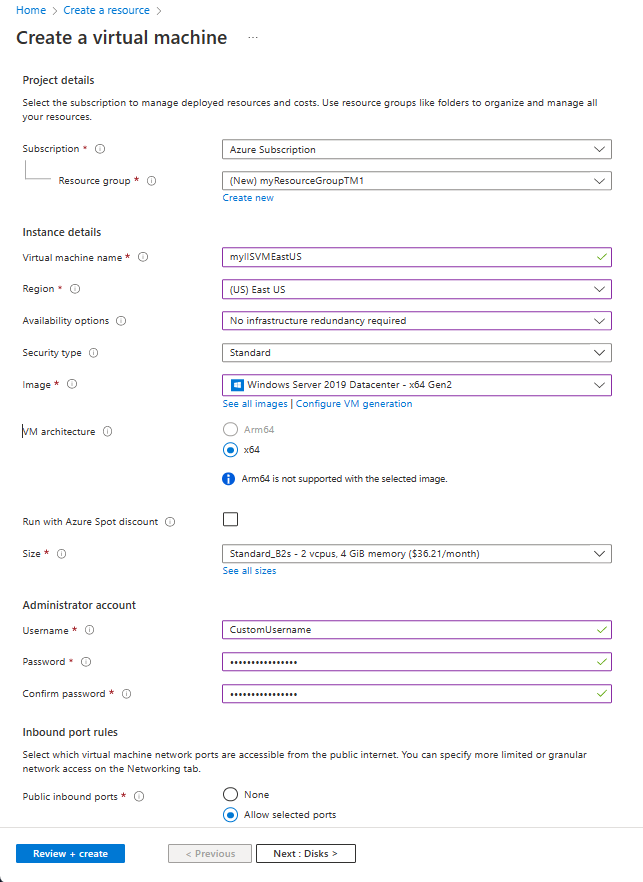
Select the Management tab, or select Next: Disks, then Next: Networking, then Next: Management. Under Monitoring, set Boot diagnostics to Disable.
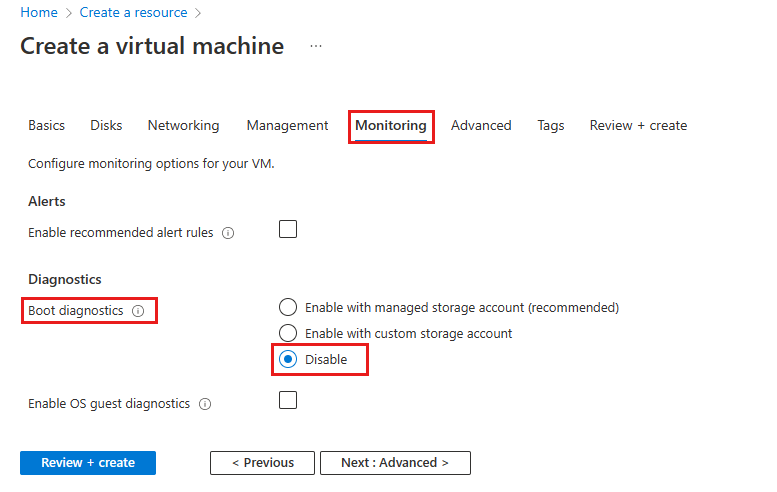
Select Review + create.
Review the settings, and then select Create.
Follow the steps to create a second VM named myIISVMWestEurope, with a Resource group name of myResourceGroupTM2, a location of West Europe, and all the other settings the same as myIISVMEastUS.
The VMs take a few minutes to create. Don't continue with the remaining steps until both VMs are created.
Connect to virtual machine
In this section, you connect to the two VMs myIISVMEastUS and myIISVMWestEurope using Bastion.
Select All resources in the left-hand menu, and then from the resources list select myIISVMEastUS that is located in the myResourceGroupTM1 resource group.
On the Overview page, select Connect, and then select Bastion.
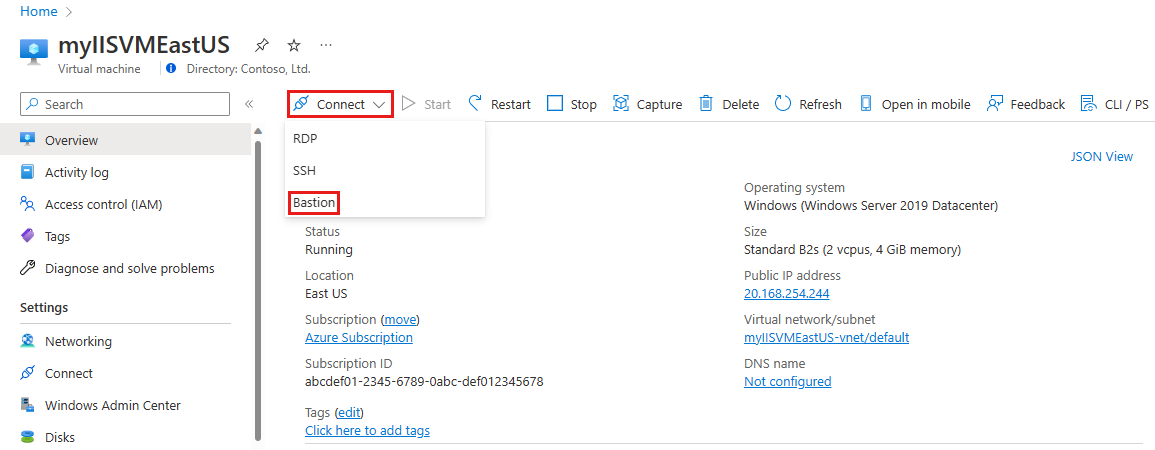
In Connect, select Use Bastion, then select Deploy Bastion.
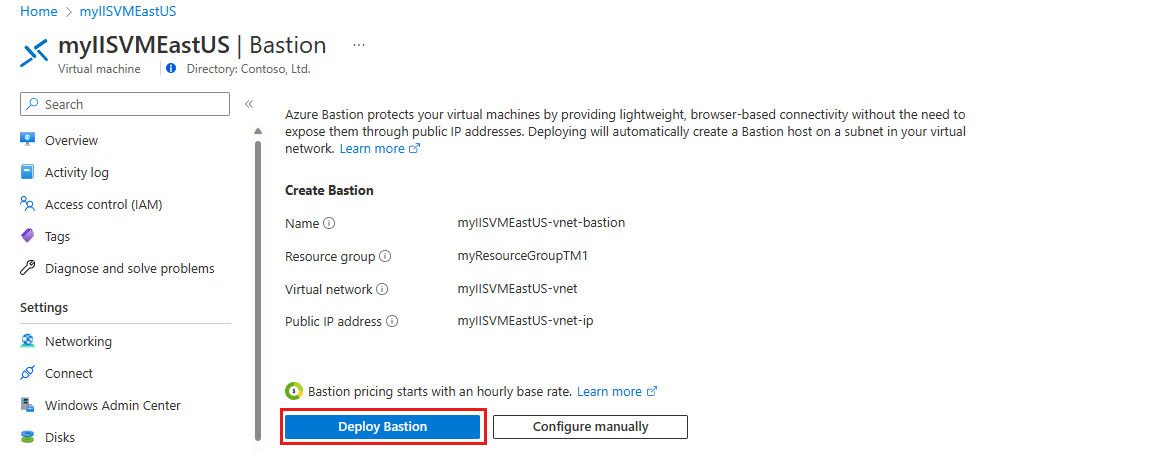
Bastion begins deploying. This can take around 10 minutes to complete.
When the Bastion deployment is complete, the screen changes to the Connect page. Type your authentication credentials. Then, select Connect.
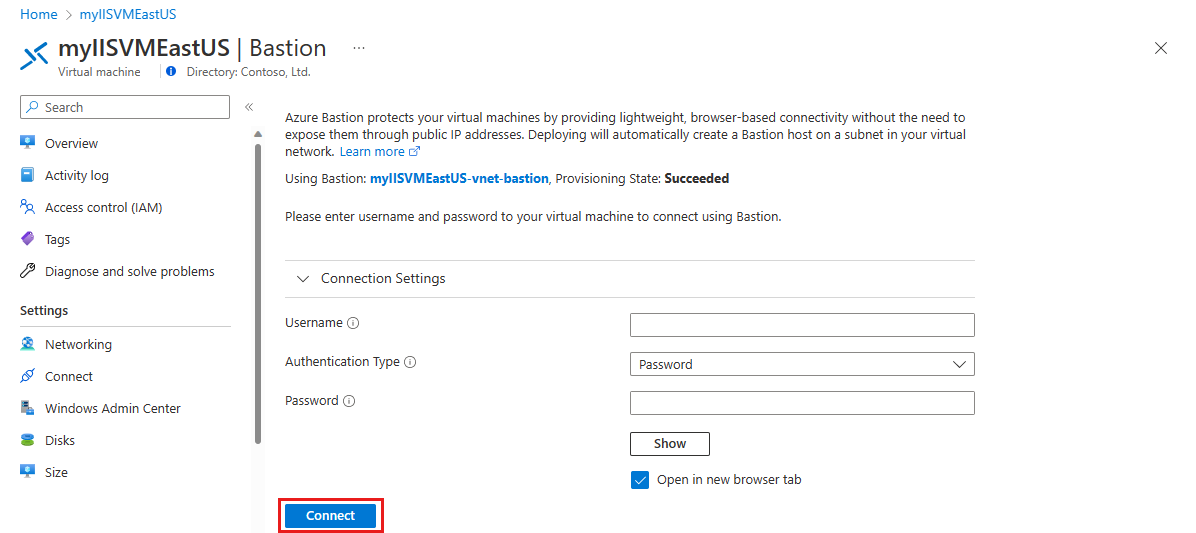
To learn more about Azure Bastion, see What is Azure Bastion?
Install IIS and customize the default web page
In this section, you install the IIS server on the two VMs myIISVMEastUS and myIISVMWestEurope, and then update the default website page. The customized website page shows the name of the VM that you're connecting to when you visit the website from a web browser.
On the server desktop, navigate to Windows Administrative Tools>Server Manager.
Launch Windows PowerShell on VM1 and using the following commands to install IIS server and update the default htm file.
# Install IIS Install-WindowsFeature -name Web-Server -IncludeManagementTools # Remove default htm file remove-item C:\inetpub\wwwroot\iisstart.htm #Add custom htm file Add-Content -Path "C:\inetpub\wwwroot\iisstart.htm" -Value $("Hello World from " + $env:computername)
Repeat steps 1-8 with by creating an RDP connection with the VM myIISVMWestEurope within the myResourceGroupTM2 resource group to install IIS and customize its default web page.
Configure DNS names for the VMs running IIS
Traffic Manager routes user traffic based on DNS name of the service endpoints. In this section, you configure the DNS names for the IIS servers - myIISVMEastUS and myIISVMWestEurope.
Select All resources in the left-hand menu, and then from the resources list, select myIISVMEastUS that is located in the myResourceGroupTM1 resource group.
On the Overview page, under DNS name, select Not-configured.
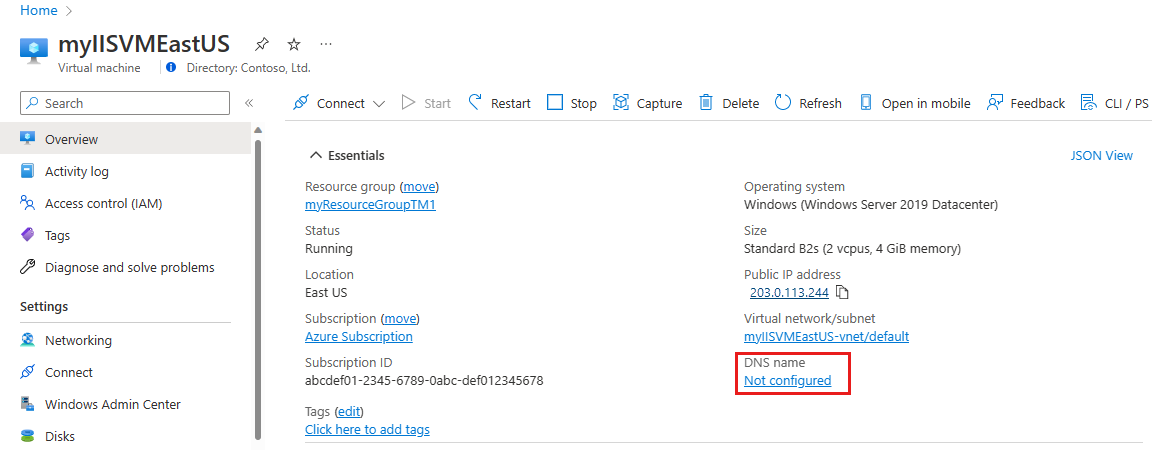
On the Configuration page, under DNS name label, add a unique name, and then select Save.

Repeat steps 1-3, for the VM named myIISVMWestEurope that is located in the myResourceGroupTM2 resource group.
Create test VMs
In this section, you create a VM (myVMEastUS and myVMWestEurope) in each Azure region (East US and West Europe). You'll use these VMs to test how Traffic Manager routes traffic to the nearest IIS server when you browse to the website.
On the upper, left corner of the Azure portal, select Create a resource > Compute > Windows Server 2019 Datacenter.
In Create a virtual machine, type or select the following values in the Basics tab:
Setting Value Subscription Select your subscription. Resource Group Select myResourceGroupTM1 in the text box. Virtual machine name Enter a name for your virtual machine. This example uses myVMEastUS. Region Select East US. Availability options Azure offers a range of options for managing availability and resiliency for your applications. For this example, select No infrastructure redundancy required. Security type Security type refers to the different security features available for a virtual machine. For this example, select Standard. Image Choose the base operating system or application for the VM. For this example, select Windows Server 2019 Datacenter. VM architecture Leave as default. Size Leave as default. Administrator Account Enter a user name and password of your choosing. The password must be at least 12 characters long and meet the defined complexity requirements. Public inbound ports Select Allow selected ports and select RDP and HTTP in the pull-down box. Select the Management tab, or select Next: Disks, then Next: Networking, then Next: Management. Under Monitoring, set Boot diagnostics to Disable.
Select Review + create.
Review the settings, and then select Create.
Follow the steps to create a second VM named myVMWestEurope, with a Resource group name of myResourceGroupTM2, a location of West Europe, and all the other settings the same as myVMEastUS*.
The VMs take a few minutes to create. Don't continue with the remaining steps until both VMs are created.
Create a Traffic Manager profile
Create a Traffic Manager profile that directs user traffic by sending them to the endpoint with lowest latency.
On the top left-hand side of the screen, select Create a resource > Networking > Traffic Manager profile > Create.
In the Create Traffic Manager profile, enter or select, the following information, accept the defaults for the remaining settings, and then select Create:
Setting Value Name This name needs to be unique within the trafficmanager.net zone and results in the DNS name, trafficmanager.net that is used to access your Traffic Manager profile. Routing method Select the Performance routing method. Subscription Select your subscription. Resource group Select the Resource group myResourceGroupTM1. Location Select East US. This setting refers to the location of the resource group, and has no impact on the Traffic Manager profile that will be deployed globally. 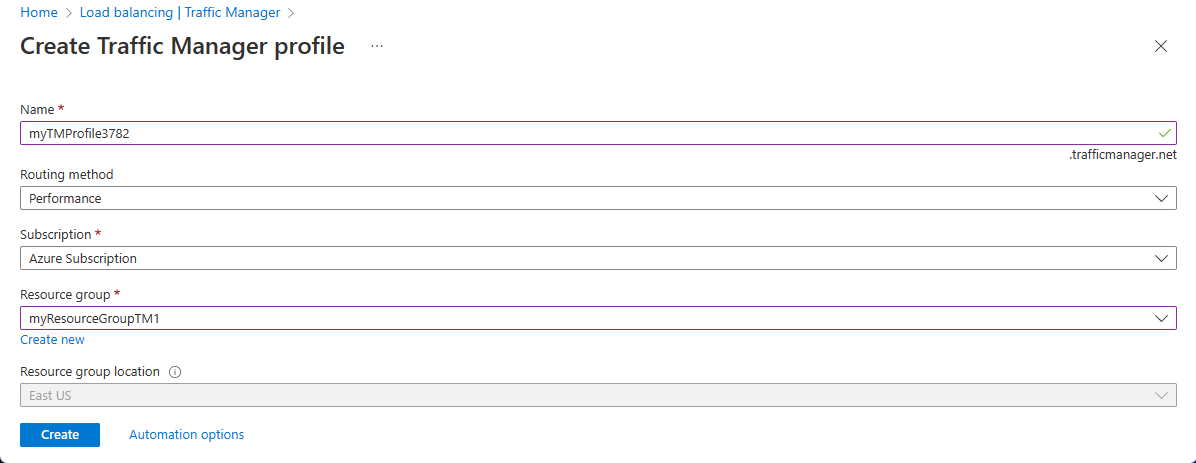
Add Traffic Manager endpoints
Add the two VMs running the IIS servers - myIISVMEastUS & myIISVMWestEurope to route user traffic to the closest endpoint to the user.
In the portal’s search bar, search for the Traffic Manager profile name that you created in the preceding section and select the profile in the results that the displayed.
In Traffic Manager profile, in the Settings section, select Endpoints, and then select Add.

In the Add Endpoint page, enter the following information, accept the defaults for the remaining settings, and then select OK:
Setting Value Type Azure endpoint Name myEastUSEndpoint Target resource type Public IP Address Target resource Choose a Public IP address to show the listing of resources with Public IP addresses under the same subscription. In Resource, select the public IP address named myIISVMEastUS-ip. This is the public IP address of the IIS server VM in East US. 
Repeat steps 2 and 3 to add another endpoint named myWestEuropeEndpoint for the public IP address myIISVMWestEurope-ip that is associated with the IIS server VM named myIISVMWestEurope.
When the addition of both endpoints is complete, they're displayed in Traffic Manager profile along with their monitoring status as Online.
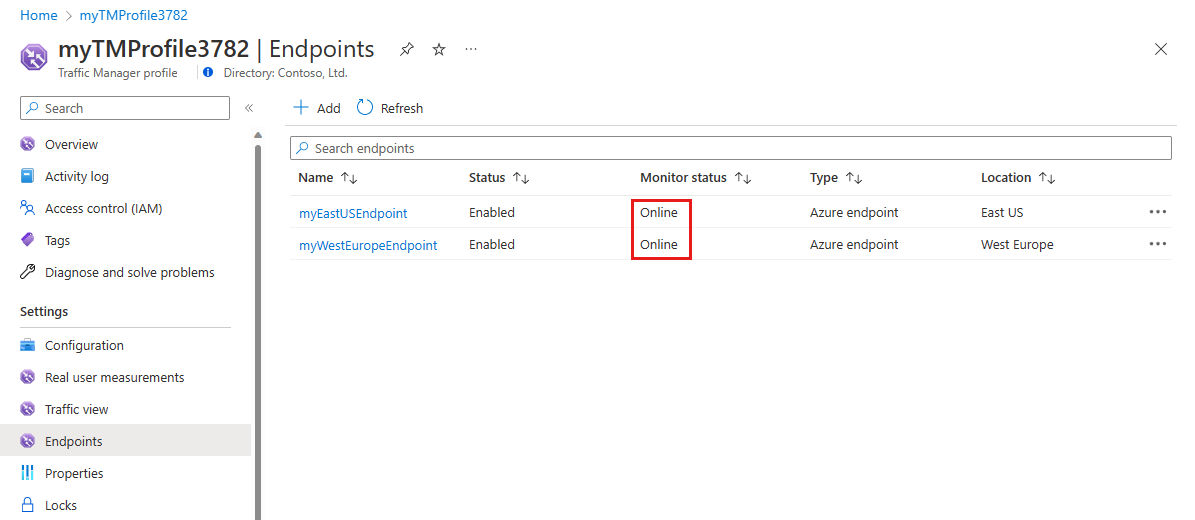
Test Traffic Manager profile
In this section, you test how the Traffic Manager routes user traffic to the nearest VMs running the website to provide minimum latency. To view the Traffic Manager in action, complete the following steps:
- Determine the DNS name of your Traffic Manager profile.
- View Traffic Manager in action as follows:
- From the test VM (myVMEastUS) that is located in the East US region, in a web browser, browse to the DNS name of your Traffic Manager profile.
- From the test VM (myVMWestEurope) that is located in the West Europe region, in a web browser, browse to the DNS name of your Traffic Manager profile.
Determine DNS name of Traffic Manager profile
In this tutorial, for simplicity, you use the DNS name of the Traffic Manager profile to visit the websites.
You can determine the DNS name of the Traffic Manager profile as follows:
In the portal’s search bar, search for the Traffic Manager profile name that you created in the preceding section. In the results that are displayed, select the traffic manager profile.
Select Overview.
The Traffic Manager profile displays the DNS name of your newly created Traffic Manager profile. In production deployments, you configure a vanity domain name to point to the Traffic Manager domain name, using a DNS CNAME record.
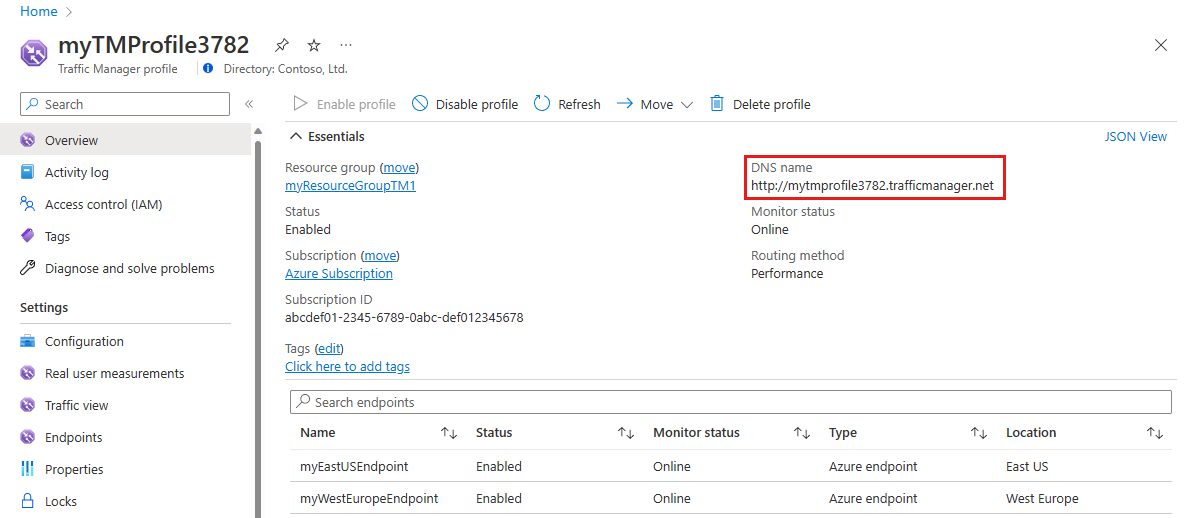
View Traffic Manager in action
In this section, you can see the Traffic Manager is action.
Select All resources in the left-hand menu, and then from the resources list select myVMEastUS that is located in the myResourceGroupTM1 resource group.
On the Overview page, select Connect, and select Bastion.
Type your authentication credentials. Then, select Connect.
In a web browser on the VM myVMEastUS, type the DNS name of your Traffic Manager profile to view your website. Since the VM located in East US, you're routed to the nearest website hosted on the nearest IIS server myIISVMEastUS that is located in East US.

Next, connect to the VM myVMWestEurope located in West Europe using steps 1-5 and browse to the Traffic Manager profile domain name from this VM. Since the VM located in West Europe, you're now routed to the website hosted on nearest the IIS server myIISVMWestEurope that is located in West Europe.

Clean up resources
When no longer needed, you can delete the resource group, virtual machine, and all related resources.
- Enter the name of your resource group in the Search box at the top of the portal and select it from the search results.
- At the top of the page for the resource group, select Delete resource group.
- A page will open warning you that you're about to delete resources. Type the name of the resource group and select Delete to finish deleting the resources and the resource group.